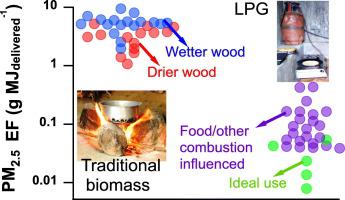Science of the Total Environment ( IF 8.2 ) Pub Date : 2020-11-23 , DOI: 10.1016/j.scitotenv.2020.143698 Mohammad Maksimul Islam , Roshan Wathore , Hisham Zerriffi , Julian D. Marshall , Rob Bailis , Andrew P. Grieshop

|
We conducted an emission measurement campaign as a part of a multiyear cookstove intervention trial in two rural locations in northern and southern India. 253 uncontrolled cooking tests measured emissions in control and intervention households during three ~3-month-long measurement periods in each location. We measured pollutants including fine particulate matter (PM2.5), organic and elemental carbon (OC, EC), black carbon (BC) and carbon monoxide (CO) from stoves ranging from traditional solid fuel (TSF) to improved biomass stoves (rocket, gasifier) to liquefied petroleum gas (LPG) models. TSF stoves showed substantial variability in pollutant emission factors (EFs; g kg-1 wood) and optical properties across measurement periods. Multilinear regression modeling finds that measurement period, fuel properties, relative humidity, and cooking duration are significant predictors of TSF EFs. A rocket stove showed moderate reductions relative to TSF. LPG stoves had the lowest pollutant EFs, with mean PM2.5 and CO EFs (g MJdelivered-1) >90% lower than biomass stoves. However, in-home EFs of LPG were substantially higher than lab EFs, likely influenced by non-ideal combustion performance, emissions from food and possible influence from other combustion sources. Therefore, in-home emission measurements may depict the actual exposure benefits associated with dissemination of LPG stoves in real world interventions.
中文翻译:

印度农村地区一项为期多年的大型炉灶干预研究中测得的生物质和液化石油气炉灶的使用中排放
作为一项为期多年的炉灶干预试验的一部分,我们在印度北部和南部的两个农村地区进行了排放量测量活动。在每个位置的三个〜3个月的测量期内,进行了253次无控制的烹饪测试,测量了控制和干预家庭的排放。我们测量了包括传统固体燃料(TSF)到改进的生物质炉灶(火箭,炉灶)在内的炉灶中的污染物,包括细颗粒物(PM 2.5),有机和元素碳(OC,EC),黑碳(BC)和一氧化碳(CO)。气化器)转换为液化石油气(LPG)模型。TSF炉灶的污染物排放因子(EFs; g kg -1)存在很大差异木材)和整个测量期间的光学特性。多线性回归模型发现,测量时间,燃料特性,相对湿度和烹饪时间是TSF EF的重要预测指标。相对于TSF,火箭炉显示出中等程度的减少。LPG炉具的污染物EF最低,平均PM 2.5和CO EFs(以MJ输送-1)比生物质炉具低90%以上。但是,LPG的室内EF远远高于实验室EF,这可能受到非理想燃烧性能,食物排放以及其他燃烧源的影响。因此,室内排放测量可以描述在实际干预中与传播LPG炉具相关的实际暴露益处。











































 京公网安备 11010802027423号
京公网安备 11010802027423号